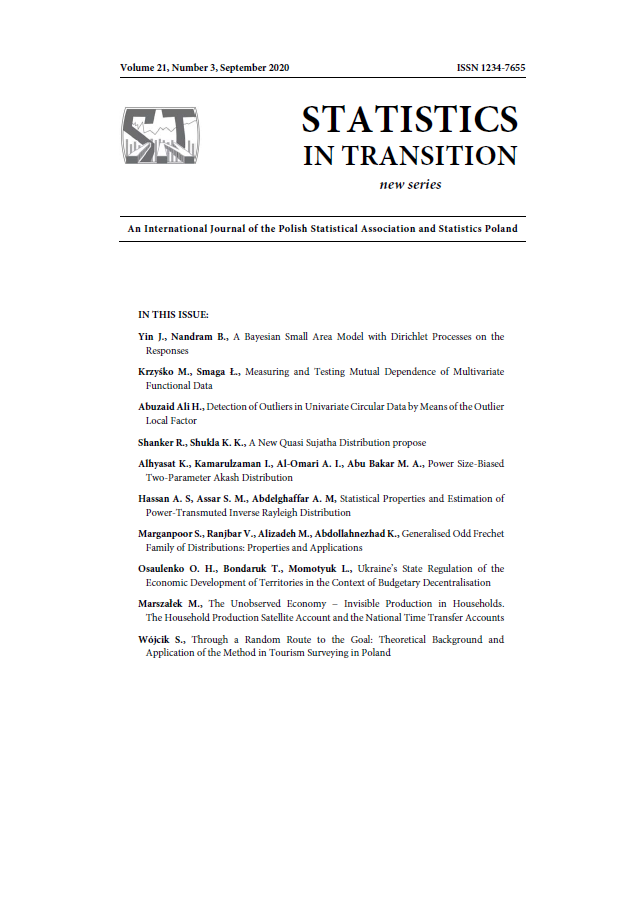ARTICLE
ABSTRACT
The paper presents the theoretical and methodological foundations of Ukraine’s state legislation regulating the economic development of territories, in the context of budget decentralization. The study also describes the transformation of the public administration system necessitated by the above-mentioned phenomenon. The authors discuss the basic methods by which the state can regulate the activity of local self-government bodies: the legislative regulation, where the intervention of public authorities is minimized, and the administrative regulation, which provides rules and instructions which determine the relations between central and local authorities. The authors conduct and describe a methodologically consistent, systematic analysis of state regulations which support the local self-governments’ activity. The paper also discusses the recent economic changes in Ukraine which demonstrate that the reform of the local self-government system and the decentralization of authority entail both prospects and problems for the country's development. As might be expected, the authors focus particularly on those problems that have not been solved yet. Additionally, statistical estimations of the phenomena relating to the process of producing state legislation regulating the economic development of territories in the context of budgetary decentralization have been provided. The authors conclude that a successful territorial development strategy requires a joint transformation of the way of the society’s thinking and the modernisation of both the Ukrainian business and the state.
KEYWORDS
state regulation, budgetary decentralization, local self-government, local budget, economic development of territories
REFERENCES
BONDARUK, T. H., (2009). Mistseve samovriaduvannia ta yoho finansowe zabezpechennia v Ukraini [Local self-governance and its financing in Ukraine], Kyiv: Express [in Ukrainian].
BORYSENKO, O. P., (2012). Synehriia u konteksti systemnoho pidkhodu do problem derzhavnoi rehuliatornoi polityky u sferi zovnishnoekonomichnoi diialnosti [Synergy in the context of the system approach to regulatory policy problems in the foreign economic activities], Retrieved from, http://www.dy.nayka.com.ua/?op=1&z=459 [in Ukrainian].
BROSIO, G., (1985). Fiscal Autonomy of Non-Central Government and the Problem of Public-Spending Growth. In: Public Expenditure and Government Growth, F. Forte & A. Peacock (Eds.). (pp. 110–135), Oxford: Blackwell. Comparative Analysis of Territorial Governance and Spatial Planning Systems in Europe/Final Report, Retrieved from, https://www.nordregio.org/research/espon-compass-2016-2018/).
DOLISHNII, M., (ed.), (2001). Rehionalna polityka: metodolohiia, metody, praktyka [The regional economy: methodology, methods, practice]. (pp. 11–15). NAS of Ukraine, Institute for Regional Studies of the NAS of Ukraine, Lviv [in Ukrainian].
DZIEMIANOWICZ, W., JAŁOWIECKI, B.; współpr. KRAJEWSKA M., (2004). Polityka miejska a inwestycje zagraniczne w polskich metropoliach, [Uniwersytet Warszawski]. Centrum Europejskich Studiów Regionalnych i Lokalnych. Warszawa: “Scholar”, pp. 130–134.
GRIBANOVA, G. M., (1998). Mestnoe samoupravlenie v Zapadnoy Evrope: Sravnitelnyiy analiz politiko-sotsiologicheskih aspektov [Local self-governance in Western Europe: a comparative analysis of political and sociological aspects], Saint- Petersburg: Herzen State Pedagogical University of Russia [in Russian].
GRIGOREV, L., TAMBOVTSEV, V., (2008). Modernizatsiya cherez koalitsii [Modernization through coalitions]. Voprosyi ekonomiki – Problems of economics, 1, pp. 59–70 [in Russian].
HEIETS, V. M., (1999). Transformatsiia. Modeli ekonomiky Ukrainy [Transformation. Models of the Ukrainian economy]. Kyiv [in Ukrainian].
HOOGHE, E., MARKS, G., (2003). Unraveling the Central State, but How? Types of Multi-level Governance. American Political Science Review, 97(2), pp. 233–243.
KVASHA, S. M., (2013). Metodolohichnyi bazys pryiniattia suspilnykh rishen v ahrarnii politytsi [The methodological framework for taking social decisions in the agrarian policy]. Ekonomika APK – Economics of agroindustrial complex, 8, pp. 12–21 [in Ukrainian].
LIDSTRÖM, A., (2007). Territorial Governance in Transition. Regional and Federal Studies, 17(4), pp. 499–508.
LUNINA, I., (2014). Biudzhetna detsentralizatsiia: tsili ta napriamy reform [Budget decentralization: goals and directions of reforms]. Ekonomika Ukrainy – Economy of Ukraine, 11, pp. 61–75 [in Ukrainian].
MUSGRAVE, R. A., (1959). The Theory of Public Finance: A Study in Public Economy. New York: McGraw-Hill. P. 84.
MYKHASIUK, I. R., MELNYK, A. F., KRUPKA, M. I., ZALOHA, Z. M., (1999). Derzhavne rehuliuvannia ekonomiky [Regulation of the economy]. Lviv: Ukrainski tekhnolohii [in Ukrainian].
NADIN, V., STEAD, D., (2013). Opening up the compendium: An evaluation of international comparative planning research methodologies. European Planning Studies, 21(10), pp. 1542–1561.
REIMER, M., GETIMIS, P., BLOTEVOGEL, H., (eds.) (2014). Spatial planning systems and practices in Europe: A comparative perspective on continuity and changes. London and New York: Routledge.
STAVNYCHA, M. M., SOBETSKA, YU. S., (2014). Tendentsii formuvannia dokhidnoi chastyny mistsevykh biudzhetiv Ukrainy v umovakh podolannia kryzovykh yavyshch [Forming the income part of local budgets in Ukraine in the conditions of crises]. Molodizhnyi ekonomichnyi daidzhest – Youth economic digest, 1(1), pp. 81–87 [in Ukrainian].
VARNALII, Z. S., (ed.), (2005). Rehiony Ukrainy: problemy ta priorytety sotsialnoekonomichnoho rozvytku [The regions of Ukraine: problems of priorities of socioeconomic development], Kyiv: Znannia Ukrainy [in Ukrainian].
